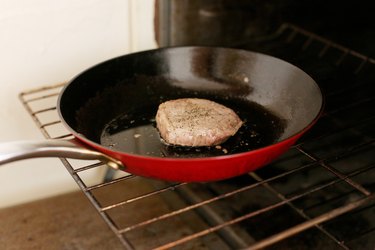Although venison steaks offer a refreshing alternative to beef, they contain much less of the marbling or fat that gives the beef steak its satisfying flavor. For this reason, pair venison with strong accompanying flavors and take care not to overcook.

Pan-Fried
Prepare venison steaks by trimming off any sinew and patting dry with paper towels to maximize their sizzle in the frying pan. Season them with salt and crushed peppercorns, pressing the latter into the steak until they hold firm. Venison needs very little time in a hot skillet of olive oil, with the caveat that overcooking will produce a dry, tough steak. For thin cuts, 2 minutes on either side is sufficient for a rare steak, resisting the temptation to turn too often. For thicker steaks, up to 8 minutes total for both sides will give a medium-rare steak. Whether rare or medium, venison steaks need rest after cooking to seal the juices. Cover with aluminum foil and leave for 5 minutes after removing from the pan.
Video of the Day
Video of the Day
Grilled
Before cooking, connective tissue on steaks from the leg needs to be sliced through with a sharp knife to stop it curling, as it will contract faster than the meat. For thin steaks that will be served rare, cool them beforehand in the refrigerator and lay on the grill cold. Otherwise, bring thicker steaks up to room temperature first to produce venison that is cooked through and moist. Grilled venison requires very little seasoning beyond a simple salt and pepper rub. Place them first on the hottest part of a propane or natural wood-fire grill and flip after a few minutes with tongs, checking for sear marks. Move to a cooler part of the grill for 4 or 5 minutes, then remove entirely and allow to rest.
Roasted
A hot oven and a short cooking time will produce a steak that is tender throughout and juicy on the inside. Preheat the oven to 450 degrees Fahrenheit and season the venison with salt and pepper. In the absence of any residual fat, the steaks will benefit from browning first in a frying pan of hot olive oil or butter for a few minutes, only until they start to crust. Transfer the pan to the oven and roast for 3 minutes per side, turning once. Remove from the oven and allow to rest.
Preparation
Choose the backstrap and tenderloin cuts for the closest counterpart to beef rib-eye and filet mignon. These need only perfunctory seasoning and minimal preparation. For other venison steaks from the leg area, refrigerating overnight marinating in vinegar, ketchup, Worcestershire sauce and crushed juniper berries in a resealable bag will break down the tougher sinews. After cooking, use a cook's thermometer to check the internal temperature, which should be 120 degrees F for rare steaks, 130 F for medium.
- Food Safety: Safe Minimum Cooking Temperatures
- Jamie Oliver: Pan-Seared Venison with Blueberries, Shallots & Red Wine
- BBC Good Food: Venison Steak with Port Sauce
- Petersen’s Hunting: How to Properly Grill Venison Steak
- Delia Online: Venison Steaks with Cranberry Cumberland Sauce
- Good Food Channel: Venison Steaks
- Waitrose: Food Glossary, Venison
- What’s Cooking America: Wild Game Recipe, Country-Fried Venison Steak Recipe